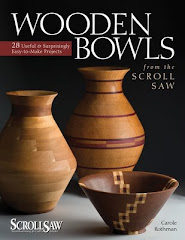I was working on a new project today, with three sets of rings. After I cut the rings, I discovered that each blank had a slight warp in it. I tried out a new approach to saving the wood, and it seems to be working.
First, I selectively sanded parts of each ring to get it to lie as flat as possible, rubbing it against sandpaper attached to a flat surface. Then, instead of gluing up several rings at once, I glued up only two to start, to take advantage of the pressure from the bowl press. I then added one ring at a time, correcting any warping by sanding the ring and the glued-up unit.
I'm not finished yet, but it looks a lot better than I thought it would. My last project ended up as "designer firewood", and I really didn't want it to happen again. I'll post a picture when I'm through, regardless of how it comes out.





